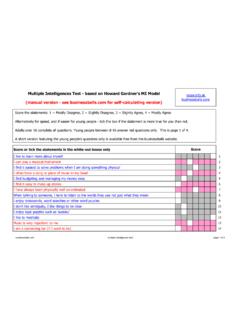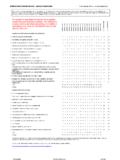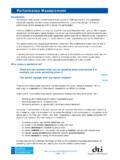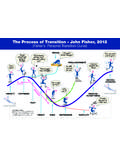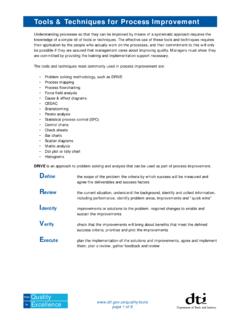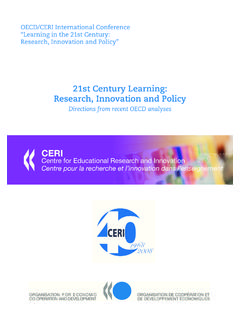Transcription of People Development & Teamwork - Businessballs
1 People Development & Teamwork Why teams? People are a fundamental building block of any TQM organisation. The only point at which true responsibility for quality can lie is with the person or group actually doing the job or carrying out the process. The complexity of most of the processes in an organisation places them beyond the control of any one individual, and the only efficient way to tackle process improvement or re-design is through the use of Teamwork . Teamwork has many advantages: A greater variety of complex issues can be tackled by pooling expertise and resources Problems are exposed to a greater diversity of knowledge, skill and experience The approach boosts morale and ownership through participative decision making Improvement opportunities that cross departmental or functional boundaries can be more easily addressed The recommendations are more likely to be implemented than if they come from an individual Employees will not engage in continuous improvement activities without commitment from senior managers, a culture for improvement and an effective mechanism for capturing individual contributions.
2 Teamwork must be driven by a strategy, have a structure and be implemented thoughtfully and effectively. When properly managed and developed, Teamwork improves processes and produces results quickly and economically through the free exchange of ideas, information, knowledge and data. It is an essential component of a total quality organisation, building trust, improving communication and developing a culture of interdependence, rather than one of independence. Little sharing of ideas Independence and information Exchange of This develops into basic information exchange of feelings and I. and ideas sharing of ideas N. T. D. E. I. A The turning point for V. M Trust the team approach - elimination of fear I. W. D. O. U. R. A progressive Development A. K. that accelerates rapidly L. Free communication following the S. establishment of trust Critical for continuing Interdependence improvement and real problem solving From Quality to Excellence page 1 of 11.
3 Roles within teams Following many years' research on teams, Dr Meredith Belbin identified a set of eight roles, which, if all present in a team, give it the best chance of success. These roles are: Co-ordinator Shaper Plant Monitor-Evaluator Implementer Resource Investigator Team Worker Finisher The Co-ordinator clarifies group objectives, sets the agenda, establishes priorities, selects problems, sums up and is decisive, but does not dominate discussions. The Shaper gives shape to the team effort, looking for pattern in discussions and practical considerations regarding the feasibility of the project. Can steamroller the team, but gets results. The Plant is the source of original ideas, suggestions and proposals that are usually original and radical. The Monitor-Evaluator contributes a measured and dispassionate analysis and, through objectivity, stops the team committing itself to a misguided task.
4 The Implementer turns decisions and strategies into defined and manageable tasks, sorting out objectives and pursuing them logically. The Resource Investigator goes outside the team to bring in ideas, information and developments to it. They are the team's salesperson, diplomat, liaison officer and explorer. The Team Worker operates against division and disruption in the team, like cement, particularly in times of stress and pressure. The Finisher maintains a permanent sense of urgency with relentless follow-through. All of these roles have value and are missed when not in a team; there are no stars or extras. An individual's team role can be determined by the completion of a Belbin questionnaire. It is not essential that teams comprise eight People each fulfilling one of the roles above, but that People who are aware and capable of carrying out these roles should be present.
5 In small teams, People can, and do, assume more than one role. In addition, analysing existing teams and their performance or behaviour, using these team role concepts, can lead to improvements, : Underachievement demands a good co-ordinator or finisher Conflict requires a team worker or strong co-ordinator Mediocre performance needs a resource investigator, innovator or shaper Error prone teams need an evaluator From Quality to Excellence page 2 of 11. Different roles are important in different circumstances, , new teams need a strong shaper to get started, competitive situations demand an innovator with good ideas, and in areas of high risk, a good evaluator may be needed. Teams should, therefore, be analysed both in terms of what team roles members can play, and also in relation to what team skills are most needed. Despite having well defined roles within a team, the interaction between the different personalities of individuals can be a frequent source of friction.
6 However, this can largely be avoided by understanding and valuing People 's differences. The Myers Briggs Type Indicator (MBTI) is a powerful aid to both team and personal Development by providing a well-researched framework for understanding these differences. It is based on identifying an individual's behavioural preferences on four scales: Extroversion Introversion how we prefer to give/receive energy or focus our attention Sensing INtuition how we prefer to gather information Thinking Feeling how we prefer to make decisions Judging Perceiving how we prefer to handle the outer world The four MBTI scales represent two opposing preferences most People are able to use both at different times, but will indicate a preference on each of these scales. In total there are eight possible preferences and an individual's MBTI type contains four E or I, S or N, T or F, and J or P.
7 Preference types should be determined by the completion of a questionnaire, its analysis, and subsequent feedback and discussion with a qualified MBTI administrator. If each preference is represented by its letter, a person's type may be shown by a four letter code, of which there are sixteen in total; , ESTJ represents an extrovert (E) who prefers to gather information by sensing (S), prefers to make decisions by thinking (T) and prefers a judging (J) attitude towards the outside world. The person with opposing preferences on all four scales would be an INFP; an introvert (I), who prefers to gather information by intuition (N), prefers to make decisions by feeling (F), and prefers a perceiving (P) attitude towards the outer world. The sixteen MBTI types are therefore: ISTJ ISFJ INFJ INTJ. ISTP ISFP INFP INTP. ESTP ESFP ENFP ENTP.
8 ESTJ ESFJ ENFJ ENTJ. From Quality to Excellence page 3 of 11. The Extrovert prefers action and the outer world The Introvert prefers ideas and the inner world Sensing-Thinking types are interested in facts, analysing them impersonally and using a step-by- step process to reach a conclusion The Sensing-Feeling types are also interested in facts, but analyse them personally and are concerned about how things matter to themselves and others Intuition-Thinking types are interested in patterns and possibilities, making decisions based on impersonal, logical analysis Intuition-Feeling types are also interested in patterns and possibilities, but make decisions based upon personal values, and their effect on individuals Judging types are seen by others as preferring to live in an orderly, planned fashion and liking to regulate and control Perceiving types are seen by others as being flexible, spontaneous, and showing a willingness to understand and adapt readily Clearly, there are more than sixteen personality types in the world, and it is important to stress that we can and do adopt all sixteen types in our day-to-day life.
9 However, everyone has a preferred type, where they feel at their most comfortable. For Teamwork , the preference types and their interpretation are very powerful, and can be used by an individual, or a team addressing a process improvement problem. It is imperative that the team does not skip those steps that require them to use their non-preferences, , information tends to be gathered by the preferred function (S or N) and decisions also made by the preferred function (T or F). So a strong ST type will prefer to gather facts (S) and think logically through the decision process (T), with insufficient time and attention being paid to emerging patterns and other possibilities (N) and the impact on People (F). Problems, solutions and decisions are likely to be improved if all the preferences are used; if team members are not experienced in spending time in their non-preferred function, they should consult others of opposing preferences.
10 If a team does not have a member with an (F) preference, for example, team members should pay particular attention to the impact of their decisions on People , as there will be a natural preference to ignore or avoid this issue. Personality differences frequently result from a conflict between two opposing types. For example, an ST. might think that an NF colleague lacks attention to detail and is not logical, therefore their judgement must be unsound. The NF might feel that the ST is picky and cannot see the whole picture, and may be offended by their apparent insensitivity to others. Use of the MBTI leads to an understanding that neither is right , or wrong . Their differences are their strength, and allow both to operate more effectively. This has great implications for Teamwork , and real advantages can be gained if all team members know their MBTI preference and share them within the team.


